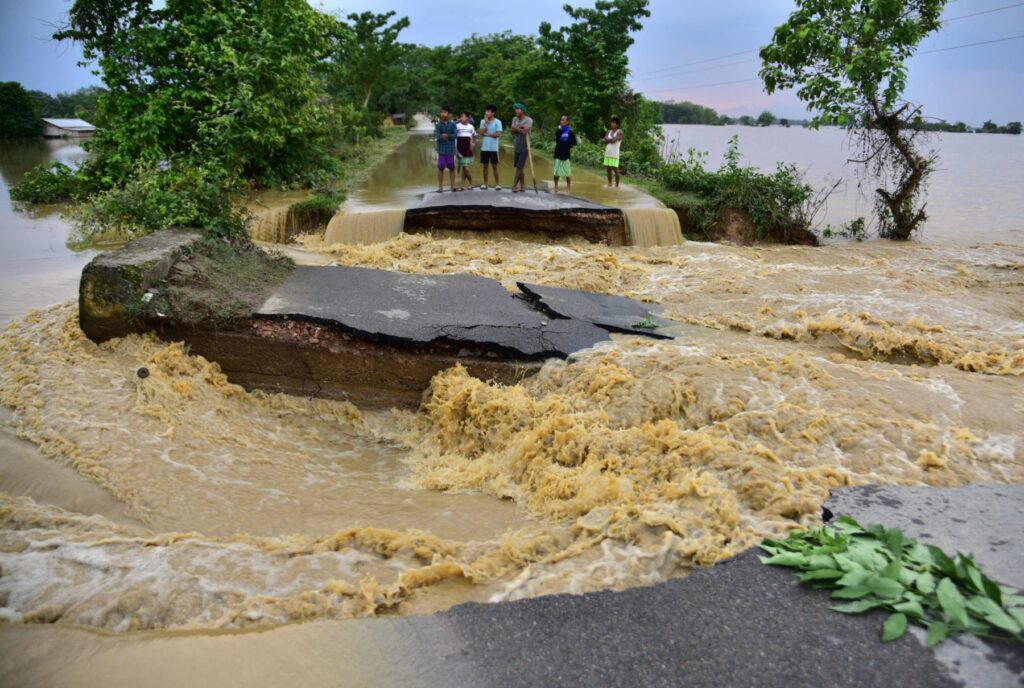Twin Crises Of Heat & Floods Expose Neglect
May 25, 2022 | Pratirodh Bureau
People stand on a road damaged by floodwaters after heavy rains in Assam's Nagaon district on 19 May 2022 (Image: Anuwar Hazarika/Alamy)
Rains over the weekend brought some relief from a sweltering heatwave to northern India, but temperatures are projected to rise again. Last week, the heat in New Delhi, India’s capital, matched that of Riyadh in Saudi Arabia, and is predicted to do so again this week. At the same time, India’s northeastern region and the neighbouring country of Bangladesh have been battered by heavy rainfall and floods.
Simultaneous disasters are becoming more common in South Asia as the climate changes, but preparation for them is limited. Much of the damage caused by floods has been exacerbated by ill-conceived development projects that have ignored environmental concerns and local input.
Climate Connect, Political Disconnect On Urban Green Spaces
The connection between climate change and the two crises of heat and flooding is clear. Strikingly, the UK’s Meteorological Office has said that “human influence has increased the likelihood of extreme April-May temperature anomalies [in northern India and Pakistan] by a factor of about 100”, and that by the end of the century the likelihood of heatwaves in the region will increase by 275 times from the natural state.
In such a situation, one would expect the Indian government to be scrambling to implement action plans. To a degree it is – and has been setting up early warning systems. The problem is that action on heat warnings is undermined by inaction on more long-term measures. According to the National Disaster Management Authority, a key adaptive measure is “land use strategies to reduce the urban heat island effect, including green infrastructure, cool roofs, trees, and vegetation, and increasing green spaces”.
In January, Bhupender Yadav, India’s environment minister, proudly released the Forest Survey of India report, claiming forest cover has grown. A closer examination, though, revealed that the survey did not distinguish between tea estates, agro-forestry and true forest cover, and what was in fact a decline in green areas was being passed off as an increase. The government also has a habit of announcing action on urban forests that never see the light of day, despite years of repetition. This is in line with many plans for better cities that are not being implemented.
More Floods Coming, But Little Preparation
The connection between climate change and the floods that began last week is also fairly clear. In a statement, independent weather expert Sanjay Srivastava said the moisture in the region is due to a cyclone, Asani. Asani petered out over the Bay of Bengal in mid-May after threatening India’s east coast, but not before pushing rainclouds inland from the sea. Cyclones are becoming more frequent and more powerful due to climate change, with the likelihood of flooding in India increasing by 50-90% in the lowest emission scenario.
The impact is devastating. The Assam Disaster Management Authority said that of 33 districts in the northeast Indian state, 22 had been affected by 22 May, impacting more than 700,000 people and 95,000 hectares of crops. Twelve people have died and over 90,000 people are already in government-run relief camps.
Bridges, rail tracks and roads were washed away or hit by landslides, affecting communication not only to parts of Assam but also to other states in the region – Tripura, Mizoram and Manipur. The floods affected forests, including in the famous Kaziranga National Park, home to the world’s largest population of one-horned rhinoceros.
Shoddy Infrastructure Worsens Floods In India
What makes this situation more problematic is that infrastructure development continues as if we are living in a business-as-usual scenario. Work is often shoddy and certainly does not factor in greater likelihood of catastrophes.
Dams in upstream Arunachal Pradesh and in Assam – many of them half-finished – have not only failed to hold back the floods, but have also sometimes channelled the rivers to flood new areas. Embankments meant to prevent flooding have instead prevented the gradual spread of the Brahmaputra and its tributaries into their floodplains, while the embankments collapse when the rainfall turns heavy. Poorly planned dredging operations meant to improve navigability in the Brahmaputra have led to silt being dumped on riverbanks. Heavy rain has now carried this silt into villages and inundated homes.
Landslides have been particularly severe on the southern bank of the Brahmaputra in Assam. This is the region where the Meghalaya plateau slopes towards the river. Illegal coal mining in many parts of Meghalaya and a few adjoining parts of Assam has led to rivers being blocked by mine tailings. Now, after heavy rainfall, the water that would have flown down those rivers has instead loosened soil along hill slopes, leading to many landslides.
Abandoning The Poor
People who live on riverine islands – both in India and Bangladesh – are often among the poorest of the population. The limited infrastructure available in these areas is often damaged by frequent floods. And yet, year after year, the residents of such areas are largely abandoned to the fury of the worsening climate crisis.
In Bangladesh, there have been a number of projects initiated by the government as well as NGOs, such as the Char Development and Settlement Project and Chars Livelihood Programme. However, these projects only help with adaptation.
This year, food price inflation is adding to worry about loss of crops and profits. Food price inflation had reached alarming levels in India and Bangladesh before the current spell of rain, and both governments are being forced to drastically increase the number of people who receive subsidised food. From 1 June, under a programme announced before the floods, 10 million people in Bangladesh will be eligible for subsidised essentials. (Published under Creative Commons from The Third Pole)
